
Zlitan was one of the municipalities (baladiyah) of Libya from 1983 to 1995. It lay in the northwestern part of the country, on the Mediterranean coast. In 1995 most of the municipality was included as part of Misrata District, where it remains As of 2009.

‘Omar al-Mukhṫār Muḥammad bin Farḥāṫ al-Manifī, called The Lion of the Desert, known among the colonial Italians as Matari of the Mnifa, was the leader of native resistance in Cyrenaica, currently Eastern Libya under the Senussids, against the Italian colonization of Libya. A teacher-turned-general, Omar was also a prominent figure of the Senussi movement, and he is considered the national hero of Libya and a symbol of resistance in the Arab and Islamic worlds. Beginning in 1911, he organised and, for nearly twenty years, led the Libyan resistance movement against the colonial Italians during the Pacification of Libya. After many attempts, the Italian Armed Forces managed to capture Al-Mukhtar near Solonta and hanged him in 1931.

Msallata is a town in the northwestern part of Libya, in the Murqub District. It has a population of nearly 2,000, and was historically a center of Islamic studies. It is also known for olive tree farming and olive oil production. The Tripolian Republic was announced in Msallata on 16 November 1918 which was the first republic in the Arab world. Along with the city of Tarhuna, it gave its name to the former Libyan district of Tarhuna wa Msalata.

A khanqah or khaniqah, also known as a ribat (رباط) – among other terms – is a building designed specifically for gatherings of a Sufi brotherhood or tariqa and is a place for spiritual retreat and character reformation. In the past, and to a lesser extent nowadays, they often served as hospices for saliks, Murids (initiates) and talibs. Khanqahs are very often found adjoined to dargahs, mosques and madrasas.

Rābiʿa al-ʿAdawiyya al-Qaysiyya was a Muslim saint and Sufi mystic. She is known in some parts of the world as, Hazrat Bibi Rabia Basri, Rabia Al Basri or simply Rabia Basri.
Khaled Yashruti was a Palestinian political activist and a leading member of the PLO.

Suluq is a town in the Benghazi District of the Cyrenaica region in northeastern Libya. It is located about 53 kilometers to the south-east of Benghazi.

The 62nd Infantry Division Marmarica was an auto-transportable Infantry Division of the Italian Army during World War II. IT was formed 9 May 1937 in Derna, Libya and was destroyed 5 January 1941 in Bardia. The Marmarica was classified as an auto-transportable division, meaning staff and equipment could be transported on cars and trucks, although not simultaneously.

Ahmed Sharif as-Senussi was the supreme leader of the Senussi order (1902–1933), although his leadership in the years 1917–1933 could be considered nominal. His daughter, Fatimah el-Sharif was the Queen consort of King Idris I of Libya.
Zawiyat al-Dahmani is a suburb of Tripoli, Libya. It lies between the coast to the north, and the suburb of Fashloom to the south.
The Fashloom district is a suburb of Tripoli, Libya. It lies inland to the south of the suburb of Zawiyat al-Dahmani, and southeast of the Martyrs' Square. It is one of the more impoverished districts of the city.

The Mosque of al-Zahir Baybars is a mosque built in Cairo, Egypt by the Mamluk Sultan al-Zahir Baybars al-Bunduqdari.

Marmarica in ancient geography was a littoral area in Ancient Libya, located between Cyrenaica and Aegyptus. It corresponds to what is now the Libya and Egypt frontier, including the towns of Bomba, Timimi, Tobruk, Acroma, Bardiya, As-Salum, and Sidi Barrani. The territory stretched to the far south, encompassing the Siwa Oasis, which at the time was known for its sanctuary to the deity Amun. The eastern part of Marmarica, by some geographers considered a separate district between Marmarica and Aegyptus, was known as Libycus Nomus. In late antiquity, Marmarica was also known as Libya Inferior, while Cyrenaica was known as Libya Superior.

For the town near Tripoli, see Janzur.
Zawiyat Ibn Arraq is located in downtown Beirut, Lebanon.

Msus or Zawiyat Msus, also Masous is a village in eastern Libya. It's located 130 km (81 mi) on the southeast of Benghazi, and far from Suluq on the same direction by 80 km (50 mi).

The Syrian Desert campaign was a military campaign launched by Syrian rebel forces affiliated with the Free Syrian Army's Southern Front and their allies in the southern Syrian Desert and the eastern Qalamoun Mountains. The aim of the offensive was to expel the Islamic State of Iraq and the Levant from the desert in southern Syria and to open a supply route between two rebel-held areas.
The East Ghouta inter-rebel conflict was an armed conflict between the rebel groups Tahrir al-Sham and al-Rahman Legion on one side, and the rebel group Jaysh al-Islam on the other, which took place in the rebel-held territories east of Damascus. Open conflict between the groups also took place exactly one year earlier, before a ceasefire was implemented.
















